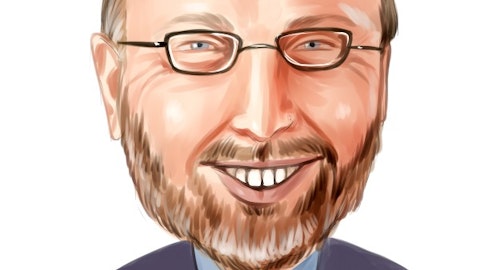Healthpeak Properties, Inc. (NYSE:PEAK) Q3 2023 Earnings Call Transcript October 31, 2023
Operator: Good morning, and welcome to the Healthpeak Properties and Physicians Realty Trust Conference Call. All participants will be in a listen-only mode. [Operator Instructions] After today’s presentation, there will be an opportunity to ask questions. [Operator Instructions] Please note that this event is being recorded. I would now like to turn the conference over to Andrew Johns, Senior Vice President, Investor Relations. Please go ahead.
Andrew Johns: Thank you. Good morning, everyone. If you have not yet downloaded the press release or merger presentation related to this call, they are available on the Healthpeak and Physicians Realty’s Web site, under Investor Relations. This morning, you’ll hear from Scott Brinker, President and CEO of Healthpeak; Peter Scott, CFO of Healthpeak; and John Thomas, President and CEO of Physicians Realty Trust. Today’s conference call will contain certain forward-looking statements. Although we believe the expectations reflected in any forward-looking statements are based on reasonable assumptions, forward-looking statements are subject to risks and uncertainties that may cause actual results to differ materially from our expectations.

A real estate investor inspecting a property, illustrating the bank’s portfolio of mortgages and real estate investments.
Factors that could cause the actual results to differ, including, but are not limited to, the potential benefit of the proposed merger and the expected timing and likelihood of completion of the transaction including the ability to obtain the requisite approval of Healthpeak and Physicians Realty shareholders form the risks that the closing conditions are not ratified. Please refer to the forward-looking statement notice in Healthpeak’s and Physicians Realty’s 10-K and other SEC filings for information. Finally, this call contains [certain] (ph) financial measures. In accordance with Reg G, the company provides a reconciliation in their respective earnings packages. And with that, I’ll turn the call over to Scott Brinker.
Scott Brinker: Thank you, Andrew, and good morning, everyone. Very excited to be here with John to discuss the merger we announced this morning, and the significant benefits to both companies. This combination will create the leading real estate platform dedicated to healthcare discovery and delivery, a large an attractive playing field with strong secular growth. We also announced strong 3Q earnings, including another increase to both same-store and earnings guidance. I’m going to ask Pete to summarize our results. Then John will do the same for DOC, who also announced 3Q results this morning. Then I’ll be back on with John to discuss the merger. Pete?
Peter Scott: Thanks, Scott. Despite the challenging capital markets environment, we continue to put up solid operating and financial results. I will be brief so we can get back to the merger we announced. For the third quarter, we reported FFO as Adjusted of $0.45 per share, AFFO of $0.40 per share, and total portfolio same-store growth of 6%. Some additional color on segment performance, starting with Outpatient Medical, same-store growth was a solid 3.4%. During the quarter, we signed 2.2 million square feet of leases, including a 20-year extension at our Medical City Dallas campus, and 143,000 square feet of leases in Philadelphia. Shifting to Lab, same-store growth was a strong 3.3%. During the quarter, we executed 211,000 square feet of leases, including converting all 196,000 square feet of previously announced LOIs into leases.
The significant deals included a 101,000 square foot lease with Pliant Therapeutics to backfill a 2023 Amgen lease expiration at our Oyster Point campus, a 61,000 square foot lease with Voyager Therapeutics to expand at our Hayden campus, in Boston, and a 23,000 square foot lease with Astellas with Vantage development, bringing that project to 52% pre-leased. All three tenants were existing tenants in our portfolio, and underscores the superior competitive advantage that incumbent landlords have. Finishing with CCRCs, our strategic and operational initiatives are producing strong results. Same-store growth for the quarter was an exceptional 32.1%, driven by occupancy gains, reduced labor costs, and margin improvement. Turning now to our 2023 guidance, we are increasing our FFO as Adjusted and AFFO guidance by two pennies at the midpoints to $1.77 and $1.53 respectively.
Additionally, we are increasing our full-year blended same-store guidance range by 75 basis points to 4.75% at the midpoint. Please refer to page 38 of our supplemental for additional detail on our guidance. With that, let me turn the call to John.
John Thomas: Thank you, Pete. Before discussing the merger, I want to take a few moments to discuss Physicians Realty Trust performance during the third quarter of 2023. During this quarter, Physicians Realty Trust generated Normalized Funds From Operations of $61.2 million or $0.25 per share. Our normalized funds available for distribution were $60.1 million or $0.24 per share. We paid our third quarter dividend of $0.23 per share on October 18, which represented a payout ratio of 96%. We ended the quarter with the balance sheet in great shape, our consolidated net debt to EBITDA ratio of 5.3 times, and less than 5% of our debt case in variable rate interest rate. Of our $2 billion of consolidated debt, only about $85 million or 4% matures before 2026.
Our revolving on a credit is completely undrawn, providing us with $1.2 billion of near-term liquidity when combined with our nearly $200 million of cash on the balance sheet. Operations remained strong, with the leasing team achieving positive absorption of 26,000 square feet, and renewal spreads of 6.7%, outpatient medical same-store cash NOI grew 1.5% year-over-year, an improvement from prior quarters as the team works to re-lease the incremental vacancy incurred earlier in the year. New investments were modest at $16.8 million, including the funding of previous loan commitments on outpatient medical facilities under construction. We also remain on track within G&A guidance of $41 million to $43 million. Our construction team is also managing to the guidance of $24 million to $26 million for recurring capital projects.
And we don’t expect any surprises there. We’re also excited to report that Physicians Realty Trust earned a score of 78 out of 100, representing a 4% year-over-year increase, and a Green Star designation in the 2023 GRESB Real Estate Assessment for sustainability reporting. I’ll now pass it over to Scott to discuss the merger.
Scott Brinker: Okay, thank you, Pete and John. From day 1, the discussion with John focused on whether both companies will be better together than as standalone entities. That was the only transaction either side was willing to do. And we accomplished that goal as the merger is expected to be accretive to both companies from every important angle; scale, earnings, balance sheet, capabilities, team, and relationships. John and I will touch on each of these items. One of the benefits of this transaction that is most exciting to John and me is that we can combine the complementary strengths of the two companies, including DOC’s internal property management and PEAK’s redevelopment and development expertise, just to name two. We expect this deal to fundamentally change the power of the combined platform, and therefore our mutual growth opportunity.
For the past year, since taking on this role at Healthpeak, I talked about several initiatives we were focused on, including having a larger playing field given the evolving nature of healthcare delivery, getting closer to our real estate, deepening our relationships and streamlining our operations. This transaction accelerates every item on that list. There’s an investor presentation on both company Web sites, but let me quickly describe the basics. This is a 100% stock merger based on the closing share price of each company as of Friday. Each DOC share will be converted into 0.674 shares of newly issued Healthpeak stock. The ownership split will be approximately 77% Healthpeak shareholders and 23% Physicians Realty shareholders. The company’s name will be Healthpeak Properties, headquartered in Denver, with the ticker symbol DOC or DOC.
We expect to maintain our dividend at $1.20 per share, resulting in an AFFO payout ratio of 80% or below. Closing is expected to occur in the first-half of 2024 subject to typical closing conditions, including shareholder votes. Let me clarify, this is not a sale for either company. There is no cash changing hands. This is a relative value trade that we believe is beneficial to both companies. And our transaction structure allows all shareholders to carry forward and participate in the immediate and future value creation. Let me touch on the financial highlights. There is immediate and compelling value creation opportunity that will grow over time. The year-one run rate synergies should be at least $40 million, with the potential to reach $60 million by the end of year-two.
Any increase in occupancy or rate will be upside to those numbers. We expect the combination to be accretive to standalone year-one AFFO for both companies. We also expect FFO accretion though that number is subject to GAAP accounting adjustments that will be finalized just prior to closing. We are even more excited about the strategic benefits. First, we have already spent a huge amount of time thinking about the team and platform from top to bottom, with a joint mindset that the status quo was never good enough. Both companies have already been operating at a high level. This is an opportunity to quickly go to the next level combining the complimentary talent and strengths of each company. Second, broader and deeper relationships, together we’ll have relationships with each of the 10 largest health systems in the country.
The vast majority of the world’s largest biopharmas and exciting mix of innovative biotechs and regional health systems. Those relationships are the intangibles that drives our performance. Third is increased operating scale with combined $40 million square feet of outpatient medical real estate including concentration in high growth markets like Dallas, Houston, Nashville, Pheonix, and many others. The combined footprint will deepen our competitive advantage in local markets. And, we haven’t included any of this potential upside in our numbers. Four, we will retain DOC’s internal property management platform and expect to internalize certain markets in our medical and lab portfolios. This will deepen our relationships and augment our local market knowledge.
The internalization will also be accretive. And we have included those profits in our synergy numbers. Five, improved tenant diversification; the top 10 tenants will represent just 21% of annual base rent. And seven of those 10 are investment grade credits. Only two tenants will represent more than 1% of our combined base rent. HCA will be our biggest tenant at 9%. And they are the largest for-profit health system in the country. It’s also a highly strategic relationship that goes back more than two decades. CommonSpirit will move from 15% of DOC’s standalone, down to 4% of the combined company. CommonSpirit is the largest not-for-profit system in the country and rated A minus by S&P. We look forward to supporting the mission of these two organizations and many others in the sector in a broader way than we could as standalone companies.
Six, this transaction will help accelerate the integration of our medical and lab operations. Independent of this merger, we are already moving toward a single operating platform as the daily blocking and tackling of property management, leasing, CapEx, forecasting, and accounting has enormous overlap between the two segments. We also see more and more of our health systems doing some level of R&D where we can be a high value-add partner given our capabilities. Seven, increased scale and liquidity for equity investors as both companies will benefit from a larger market cap. Eight is a bigger, more liquid balance sheet with leverage-expected to be in the low 5s at closing, and well-staggered debt maturities. The balance sheet will be a competitive advantage as we move forward, positioning the company to go on offence when highly levered owners are searching for answers in this new environment.
Nine, lower cost of capital through more efficient G&A and enhanced liquidity, making external growth more accretive. And 10, we will use the larger portfolio to become more active in recycling capital for our pipeline opportunities whether through outright sales or private capital joint ventures. Medical and lab remain attractive asset classes to institutional investors. And, no company will be better positioned to capitalize on their desire for exposure to the sector. Moving to the team and governance, John Thomas will join our Board as Vice Chair. And, have an active role in strategy, business development, and relationship, areas where I have seen first-hand that he excels. John has proved himself time and again as a leading voice in the sector.
And, was a driving force for growth at both Healthcare REIT and Physicians Realty. In addition, we are excited to retain the vast majority of the DOC operations and property management teams. Many of whom are reimbursed by the tenants. Kathy Sandstrom will continue to be our chairperson. And, the Healthpeak Board will be expanded to include five directors from Physicians Realty, including John and the former U.S. Secretary of Health and Human Services, Tommy G. Thompson. After closing, outpatient medical will represent approximately 50% of the combined company’s NOI. Demand exceeds supply in the outpatient sector today. And, we expect that dynamic to continue given senior population growth and high cost of new construction. We are also starting to see market rental rates catch-up to inflation, which is a positive sign for future NOI growth.
That been said, we do not have fix portfolio allocation targets moving forward. We will allocate capital based on opportunity and risk-adjusted returns. And, we do expect the opportunity set to be significant driven by four major buckets and in no particular order. First is outpatient medical acquisitions from capital-constrained owners or health systems. Second is new development with leading health systems. Third is distressed acquisition opportunities in life science driven by refinancing challenges or delayed lease up. And fourth is activating a 5 million square foot life science land bank when fundamentals are favorable. I am excited for JT to provide his thoughts and the opportunity in front of us.
John Thomas: Thank you, Scott. When John Sweet and Mark Theine asked me to join him just over 10 years ago to create a new public company focused on outpatient medical investment, I was intrigued by the opportunity to work with them to build a new kind of organization with an intense focus on serving the current, but more importantly the future needs of healthcare providers and their patients as care continued to move from the inpatient setting to the patient setting. We didn’t have an objective then or now to build a portfolio and sell it. But rather to build an organization built to last for the long term. One that grow and evolve with clinical science, the needs of an aging U.S. population, and resilient to macro and micro capital market conditions.
We wanted a culture to drive those goals. And over time to capture that culture in the acronym CARE. We communicate and collaborate. We act with integrity. We respect the relationship. And, we execute consistently. I have had the privilege to know and work with Scott since 2009 when we both had the opportunity to work together under a genuine mentor to both of us, George Chapman. We worked for Pete since his days at Barclays and collaborated with him since he joined Healthpeak. We’ve had the opportunity over the past 10 years to get to know the Healthpeak team. And more in recent weeks, we have common and consistent missions, goals, and more importantly culture. Scott has articulated, defined, achievable, measurable, and objective metrics we can and will achieve together.
We are committed to this combination not only furthers our long-term objectives from our humble beginning 15 years ago, but provides the best-in-class scale and operating platform to achieve together for our combined providers and the patients they serve far more than we can deliver separately. We are here to serve the best interest of our shareholders and stakeholders. And, we believe with all our analysis and discussions that one plus one in this context is not only more than three, but has the potential to be much more. In addition to Scott’s earlier comments, there is an additional benefit to DOC’s existing shareholders as we are merging with the best-in-class lab portfolio with large footprints and lab investment platforms in Cambridge, South San Francisco, and San Diego at an incredibly great valuation and time for investment in the existing lab platform is what we believe is an outsized ROI for years to come.
Healthpeak’s Class A lab facilities are incredible real estate hosting some of world’s leading scientists, clinicians, and discovery sponsored by and backed by leading pharma, venture capital, and academic proximity and involvement. The combination of Healthpeak’s lab teams and DOC’s operational platform further enhances the value of these assets and relationships. A true Healthpeak’s best-in-class lab and markets and shares a vision for the development of existing land owned by Healthpeak in Cambridge, in South San Francisco that should generate outsized growth of years to come, focus on lab and community development but also outpatient medical access. Scott and I led under George Chapman’s leadership, a large investment at Cambridge in 2010.
And working together learnt real estate investment, development, and operations together. Result of that investments speak for themselves. Obviously, Scott has taken that experience and executed consistently as Healthpeak’s leader. I am very excited to partner with him and collective team to further the combined company’s future opportunities in lab, and of course, outpatient medical. In conclusion, DOC is not selling an outpatient medical portfolio to Healthpeak. Healthpeak is not selling lab or outpatient facility to DOC. Rather, we believe we are combining the best of both organizations in an all-stock merger of equals that we believe will benefit both shareholder bases and continues the mission, vision, and culture of each organization as one.
This combination furthers each of our goals to have and build an organization both to last for the long term. One that grow and evolve with clinical science, the needs of an aging U.S. population, and resilient in macro and micro capital market conditions. We believe this combination meets and exceeds all of those objectives. I look forward to working with Scott and our collective team and Board. And as we say at DOC, this is an opportunity to invest in better as Healthpeak. And you will be able to find us at the New York Stock Exchange under the stock symbol DOC. Thank you. We’ll now be happy to take your questions.
See also 12 Best Long-Term Stocks To Buy According To Warren Buffett and 11 Best Immunotherapy Stocks To Buy Now.
Q&A Session
Follow Healthpeak Properties Inc. (NYSE:DOC)
Follow Healthpeak Properties Inc. (NYSE:DOC)
Operator: Certainly. We will now begin the question-and-answer session. [Operator Instructions] Our first question comes from the line of Michael Griffin with Citigroup. Your line is open.
Michael Griffin: Great, thanks. I’m curious if you can elaborate, maybe Scott, just on the on versus off-campus of the combined company. PEAK historically has been more on-campus-focused, DOC has been more off-campus. So, is there going to be a strategy shift in terms of preference there?
Scott Brinker: Yes, I would just say that the portfolios are really complementary. I mean there’s a lot of overlap in the markets themselves, something in the range of 70% market overlap, they have huge concentration in a lot of our big markets, like Dallas and Houston, and Phoenix, it’s a pretty long list, as well as some new markets, like Atlanta. We are higher on-campus, that’s been a good strategy over the years, it’s produced good results. But I think DOC has high-quality assets in kind of a different and complementary way. Certainly healthcare is moving more off-campus, doesn’t mean it’s completely moving off-campus. Our hospitals are still busy; those on-campus MOBs are still performing. But if you think about the trend in delivery, progressive health systems today have 10 or more outpatient assets for every one hospital in their system with, often times, a strategic plan to move more towards a 20:1 ratio.
And just, almost by default, most of those new assets are off campus, trying to make care more convenient, more assessable, and more affordable. So, we still like on-campus real estate, but we think we have to complement it and serve our health system partners more comprehensively, and off-campus just has to be part of that strategy. If you look at the segment or the sector in the aggregate, it’s probably only 30% on-campus. So, it’s just not realistic to think that you can do a true partner of choice with health systems if you’re only serving that 30% of the real estate footprint.
Michael Griffin: Got you, that’s helpful. And then, I’m just curious if you could maybe give us a little color on how these talks came to be, the merger of equals? Over time, how did things evolve or anything there would be pretty helpful?
Scott Brinker: Yes, we’ll put out proxy with all of that background information in the next month or two mark. But I’ll probably defer that answer until that’s made public.
Michael Griffin: Okay. Well, that’s it for me. Thanks for the time.
Scott Brinker: Yes, thanks.
Operator: Our next question comes from the line of Austin Wurschmidt with KeyBanc. Your line is open.
Austin Wurschmidt: Thanks. Good morning, everyone. I was hoping you could provide some additional detail around the synergy components within the $40 million to $60 million that you flagged? And do you expect it will be accretive immediately upon closing? And can you give us a sense about the magnitude of accretion you expect in the first year?
Peter Scott: Yes, hey, Austin, it’s Pete here. Good question. As we said, we do expect the transaction to be accretive to both AFFO and FFO per share. I will note, and I think everybody knows this at this point, but FFO has a lot of accounting adjustments, including a mark-to-market of the debt, and that won’t be finalized until the deal closes. But everything I’ve just said is based on our best estimates as of today. And importantly, those accounting adjustments do not impact AFFO. The accretion of $40 million to $60 million, I think that the biggest component of that are compensation savings. There will be some redundancies within both organizations. There’s also corporate overhead savings, notably some significant professional fee savings from having one public company as opposed to two, and then the increased NOI from internalizing property management across the portfolio.
So, those are the biggest pieces. But to answer your initial part of the question, we do expect it to be accretive in year-one.
Austin Wurschmidt: No, that’s helpful. And then, I’m just curious, so with the combined company, the PEAK team has highlighted the potential mark-to-market growth opportunity, I think it’s in 2025 with the lab space segment. And DOC has talked about, I think it’s ’26 when you’ve got the significant maturities with an attractive mark-to-market as well. I’m just curious how you thought about how this would dilute that growth in the years ahead and then how you backfill that through some of the other opportunities that you’ve discussed in LA?
Scott Brinker: Yes, hey, Austin, I’ll take a shot at that. Pete and John may have comments as well. But overall, we view this transaction as augmenting our internal growth profile, certainly making it less volatile and more predictable. But in addition to just the initial synergies that Pete just described, our capabilities in serving our clients is going to increase pretty materially, whether it’s our development and redevelopment capabilities, internal property management, the additional scale in the local markets, it just brings us closer to the real estate, closer to our tenants. That should drive better economics. And if you think about the last 10 years in lab versus the last 10 years in medical, it’s not necessarily going to repeat itself.
From where we sit, our medical growth over the past decade has been in the mid 2% range, so slightly above inflation. But we have five to six-year lease terms on average, and we are starting to see market rental rates catch up to inflation. There’s obviously a lag given that weighted average lease term, but we are starting to see some pretty significant rental rate growth. And DOC has been reporting the same. So, I think if you look at the go-forward, we’re pretty optimistic about the growth rate within outpatient medical. We see demand exceeding supply really across the entire industry, including in our local market. So, should be a pretty compelling future growth rate that might look different than the last 10 years in that medical business.
Austin Wurschmidt: And that’s very helpful. Thank you.
Operator: Our next question comes from the line of Juan Sanabria with BMO Capital Markets. Your line is open.
Juan Sanabria: Hey, guys, congrats on getting the deal done. Just a question on asset management, I guess for Scott Brinker. You guys had tremendous scale, particularly in the lab markets. And just curious on why the change of strategy about embracing the internal property management, and if you could dive a little bit into it, how should we think about how much NOI that business generates just from a synergy or accretion perspective?
Scott Brinker: Yes, happy to take that one, Juan. Really, in the last year, one of the major initiatives that we’ve been pushing as a leadership team is to bring our company closer to our real estate, closer to our buildings, local markets and relationships. And having the internal property management allows us to be that much closer to our tenants in our buildings. And we feel like we’re a little bit redundant, maybe one step removed in some cases with third-party property managers. And we think we can eliminate that, improve the relationship, improve our local market knowledge. And doing it off the back of DOC’s existing platform just allows us to do it faster. It’s less execution risk, and it will have a higher margin just given we don’t have to start from scratch.
So, it’s a pretty significant part of the synergy number that Pete described. Some of that comes immediately because there are a number of markets that we’ve already identified that we can internalize right away. And then, over time, depending upon how it goes, we could increase that number. So, it’s one of the really interesting and intriguing parts of this merger, that it’s not only financially accretive in a pretty meaningful way, but it’s strategically important in that it brings us that much closer to our real estate.




